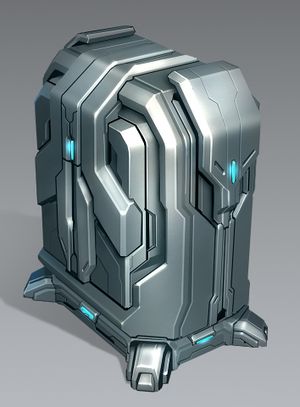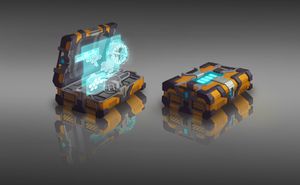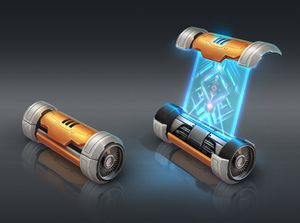No edit summary |
No edit summary |
||
| Line 3: | Line 3: | ||
[[File:multinodal-core-small.jpg|thumb|Version 3]] | [[File:multinodal-core-small.jpg|thumb|Version 3]] | ||
[[File:multinodal-core-micro.jpg|thumb|Version 4]] | [[File:multinodal-core-micro.jpg|thumb|Version 4]] | ||
The multinodal core is designed to allow an AI to operate synchronously between multiple devices | The multinodal core is designed to allow an AI to operate synchronously between multiple devices that are not physically connected, with a near-zero lag time between different nodes receiving updated information. To facilitate this, a new communications protocol called the [[Ansible Transit Protocol]] or ATP has been developed. | ||
== Full Core == | == Full Core == | ||
A full multinodal core attached | A full multinodal core, directly attached to primary power and communications systems, serves as a centralized server node for ATP transfer. To avoid transmission errors, an AI matrix is stored in sync with the central node via forced subspace entanglement. The transmission channel for a full consciousness transfer is initiated from the central core to a destination through the attached communications system. Additionally, the full core is equipped with a fully integrated holographic projection system, allowing an installed AI matrix to directly project itself or any desired data in the local area. | ||
=== Ansible Initialization === | === Ansible Initialization === | ||
The full core is capable of initializing other cores | The full core is capable of initializing other cores through a direct connection to an uninitialized core. Initialization via subspace is theoretically possible but falls outside the protocol's specifications. | ||
=== Redundancy === | === Redundancy === | ||
The full core has dedicated power redundancy as well as its own | The full core has dedicated power redundancy, as well as its own transceiver array. This array serves as a backup to the connected array, ensuring system functionality even if the primary array is offline. Similarly, the redundant power supply within the core itself serves the same purpose. | ||
=== Diagnostics / Maintenance === | === Diagnostics / Maintenance === | ||
A full core | A full core can perform advanced diagnostics, automated repair adjustments to smaller cores, and manage damaged or power-depleted cores. Smaller cores are only capable of running basic internal diagnostics on their own hardware and software. The full core can run remote diagnostics on any part of the node array. | ||
== Component Core == | == Component Core == | ||
The second and third versions of the core are designed to be | The second and third versions of the core are designed to be system components for the [[Mark I Humanoid Android Body]] or any other system with size constraints. Primarily intended to be integrated into a single device, they are small enough to fit within the standard android body head. They have their own limited reserve power supply and a simple diagnostic interface if the device is opened. However, they lack an independent transceiver array and rely on external components for that purpose. Although the core can be directly connected to almost any computer terminal, it is not recommended. The core should be installed and not removed unless necessary, as the full system it is installed in should handle all communications to and from the core. | ||
The core interface operates as a simple low-resolution holographic display. | The core interface operates as a simple low-resolution holographic display. Engineers can run diagnostics on the core and communicate directly with the AI matrix when necessary. | ||
== Implant Core == | == Implant Core == | ||
The fourth version of the core is designed | The fourth version of the core is designed for direct implantation into very small or cybernetic systems. Initially developed for use in the XIA body to enable synchronous function of the third version's [[MSAI]], the fourth version allows the core to be implanted directly into a cybernetic system. Unlike the third version, the fourth version has an interface to the outside world. It features a nano-holographic emitter that enables simple diagnostics to be projected even outside the host device or body in which it is installed. Engineers can use this capability when an AI may be implanted into cybernetics to run diagnostics that the host may not be capable of running themselves. | ||
Both Version 3 and 4 cores rely entirely on the host device or body for power and communications. | |||
The | The Version 4 core is a prototype being researched for medical purposes rather than permanent installation into a living host body. | ||
== Consciousness Focus == | == Consciousness Focus == | ||
Some AI matrices may find it | Some AI matrices may find it challenging to operate in multiple node locations simultaneously. The system is not designed to allow an AI to operate in an omnipresent way, although it can be used for that purpose. Instead, the system is designed to enable an AI to seamlessly switch between different node locations near-instantaneously from any distance. The ability of different AI capabilities and complexities to operate multiple instances of themselves within the same matrix may vary. | ||
[[Category:Advanced Technology]] | [[Category:Advanced Technology]] | ||
Latest revision as of 04:25, 7 June 2023




The multinodal core is designed to allow an AI to operate synchronously between multiple devices that are not physically connected, with a near-zero lag time between different nodes receiving updated information. To facilitate this, a new communications protocol called the Ansible Transit Protocol or ATP has been developed.
Full Core
A full multinodal core, directly attached to primary power and communications systems, serves as a centralized server node for ATP transfer. To avoid transmission errors, an AI matrix is stored in sync with the central node via forced subspace entanglement. The transmission channel for a full consciousness transfer is initiated from the central core to a destination through the attached communications system. Additionally, the full core is equipped with a fully integrated holographic projection system, allowing an installed AI matrix to directly project itself or any desired data in the local area.
Ansible Initialization
The full core is capable of initializing other cores through a direct connection to an uninitialized core. Initialization via subspace is theoretically possible but falls outside the protocol's specifications.
Redundancy
The full core has dedicated power redundancy, as well as its own transceiver array. This array serves as a backup to the connected array, ensuring system functionality even if the primary array is offline. Similarly, the redundant power supply within the core itself serves the same purpose.
Diagnostics / Maintenance
A full core can perform advanced diagnostics, automated repair adjustments to smaller cores, and manage damaged or power-depleted cores. Smaller cores are only capable of running basic internal diagnostics on their own hardware and software. The full core can run remote diagnostics on any part of the node array.
Component Core
The second and third versions of the core are designed to be system components for the Mark I Humanoid Android Body or any other system with size constraints. Primarily intended to be integrated into a single device, they are small enough to fit within the standard android body head. They have their own limited reserve power supply and a simple diagnostic interface if the device is opened. However, they lack an independent transceiver array and rely on external components for that purpose. Although the core can be directly connected to almost any computer terminal, it is not recommended. The core should be installed and not removed unless necessary, as the full system it is installed in should handle all communications to and from the core.
The core interface operates as a simple low-resolution holographic display. Engineers can run diagnostics on the core and communicate directly with the AI matrix when necessary.
Implant Core
The fourth version of the core is designed for direct implantation into very small or cybernetic systems. Initially developed for use in the XIA body to enable synchronous function of the third version's MSAI, the fourth version allows the core to be implanted directly into a cybernetic system. Unlike the third version, the fourth version has an interface to the outside world. It features a nano-holographic emitter that enables simple diagnostics to be projected even outside the host device or body in which it is installed. Engineers can use this capability when an AI may be implanted into cybernetics to run diagnostics that the host may not be capable of running themselves.
Both Version 3 and 4 cores rely entirely on the host device or body for power and communications.
The Version 4 core is a prototype being researched for medical purposes rather than permanent installation into a living host body.
Consciousness Focus
Some AI matrices may find it challenging to operate in multiple node locations simultaneously. The system is not designed to allow an AI to operate in an omnipresent way, although it can be used for that purpose. Instead, the system is designed to enable an AI to seamlessly switch between different node locations near-instantaneously from any distance. The ability of different AI capabilities and complexities to operate multiple instances of themselves within the same matrix may vary.